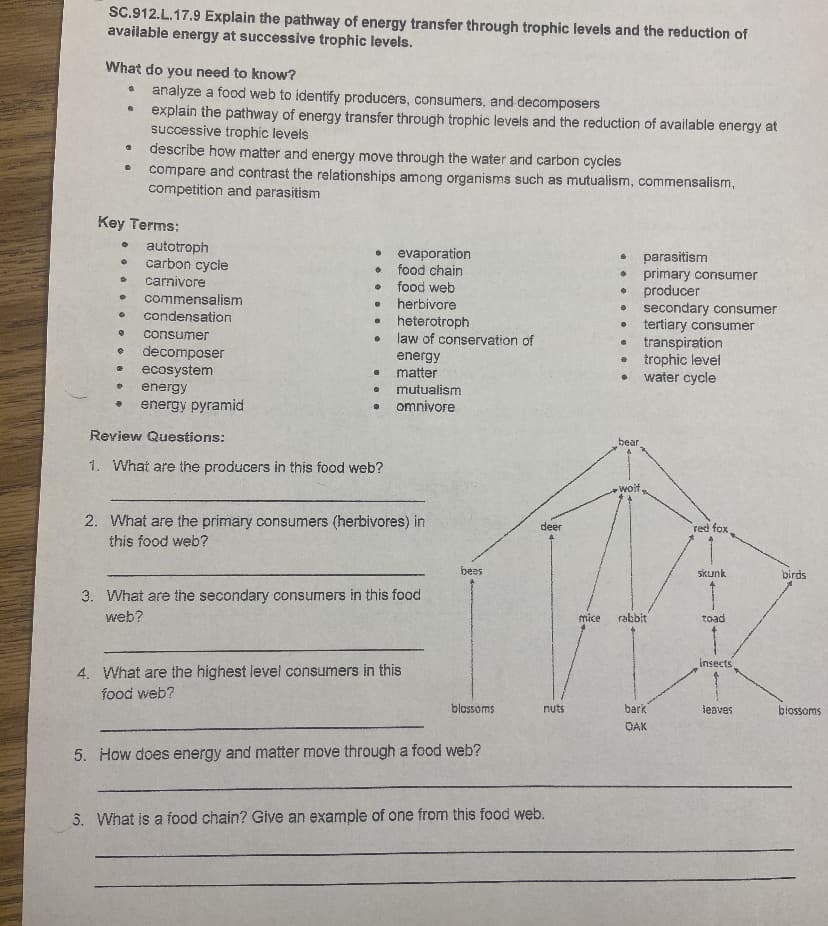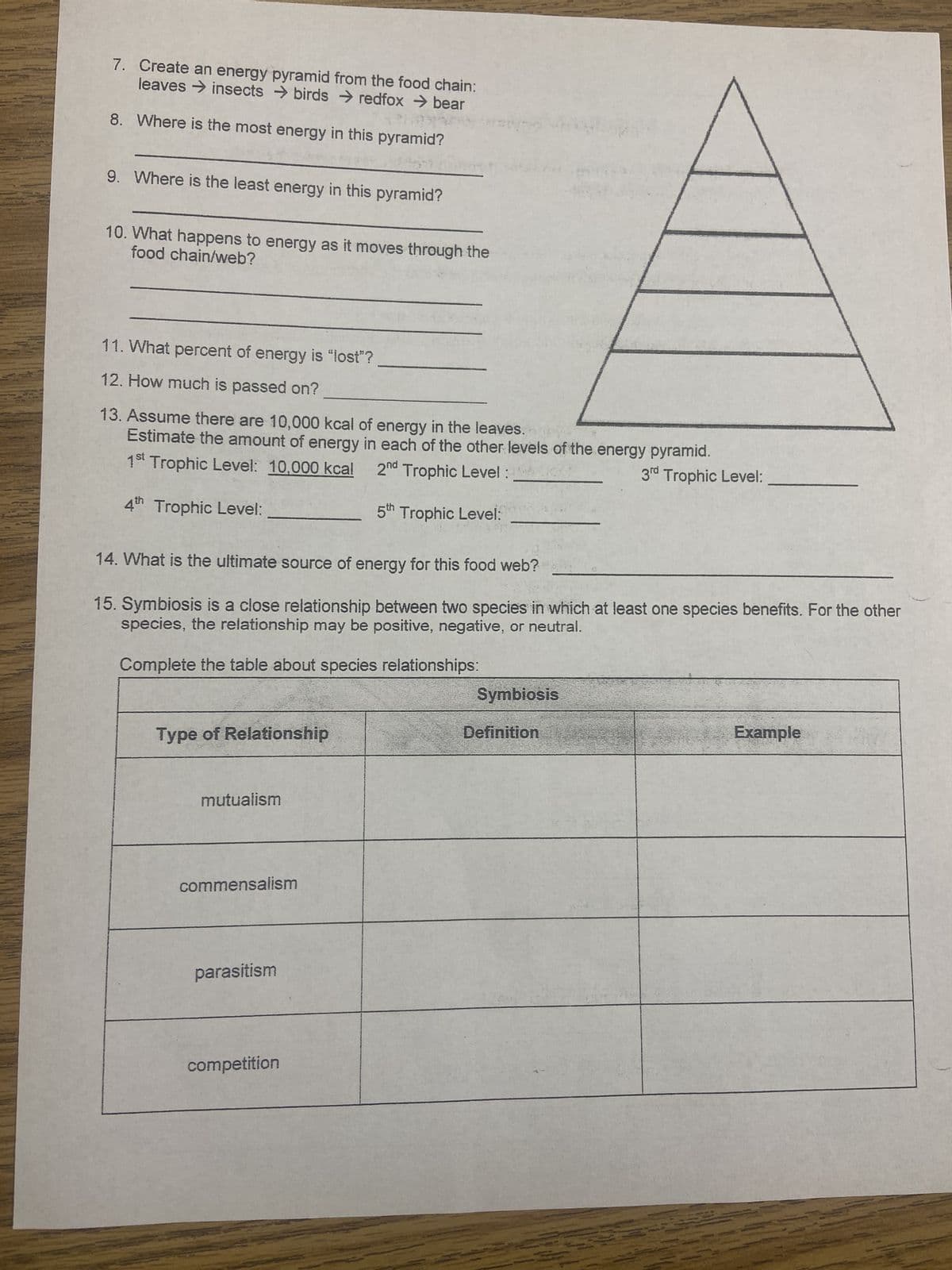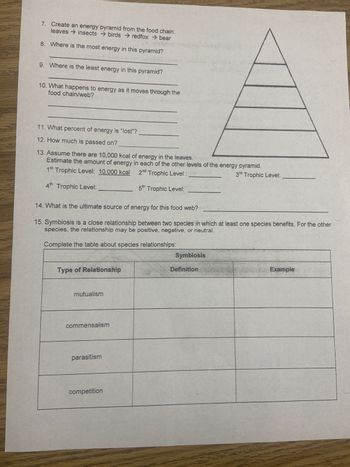SC.912.L.17.9 Explain the pathway of energy transfer through trophic levels and the reduction of available energy at successive trophic levels. What do you need to know? 0 . - ● D → Key Terms: # analyze a food web to identify producers, consumers, and decomposers explain the pathway of energy transfer through trophic levels and the reduction of available energy at successive trophic levels • autotroph . describe how matter and energy move through the water and carbon cycles compare and contrast the relationships among organisms such as mutualism, commensalism, competition and parasitism commensalism • condensation @ consumer e decomposer e ecosystem * energy carbon cycle carnivore energy pyramid • • • Ⓡ ● @ . . * Review Questions: . What are the producers in this food web? evaporation food chain food web herbivore heterotroph law of conservation of energy matter mutualism omnivore What are the primary consumers (herbivores) in this food web? What are the secondary consumers in this food web? What are the highest level consumers in this food web? bees blossoms deer nuts 8 • ▸ 0 · tertiary consumer transpiration e trophic level water cycle • bear parasitism primary consumer producer secondary consumer wolf. mice rabbit bark OAK red fox skunk toad insects leaves birds blossoms
SC.912.L.17.9 Explain the pathway of energy transfer through trophic levels and the reduction of available energy at successive trophic levels. What do you need to know? 0 . - ● D → Key Terms: # analyze a food web to identify producers, consumers, and decomposers explain the pathway of energy transfer through trophic levels and the reduction of available energy at successive trophic levels • autotroph . describe how matter and energy move through the water and carbon cycles compare and contrast the relationships among organisms such as mutualism, commensalism, competition and parasitism commensalism • condensation @ consumer e decomposer e ecosystem * energy carbon cycle carnivore energy pyramid • • • Ⓡ ● @ . . * Review Questions: . What are the producers in this food web? evaporation food chain food web herbivore heterotroph law of conservation of energy matter mutualism omnivore What are the primary consumers (herbivores) in this food web? What are the secondary consumers in this food web? What are the highest level consumers in this food web? bees blossoms deer nuts 8 • ▸ 0 · tertiary consumer transpiration e trophic level water cycle • bear parasitism primary consumer producer secondary consumer wolf. mice rabbit bark OAK red fox skunk toad insects leaves birds blossoms
Biology: The Dynamic Science (MindTap Course List)
4th Edition
ISBN:9781305389892
Author:Peter J. Russell, Paul E. Hertz, Beverly McMillan
Publisher:Peter J. Russell, Paul E. Hertz, Beverly McMillan
Chapter54: Ecosystems And Global Change
Section: Chapter Questions
Problem 9TYK: The amount of energy available at the highest trophic level in an ecosystem is determined by: a....
Related questions
Question
please answer all quest

Transcribed Image Text:SC.912.L.17.9 Explain the pathway of energy transfer through trophic levels and the reduction of
available energy at successive trophic levels.
What do you need to know?
4
a
analyze a food web to identify producers, consumers, and decomposers
explain the pathway of energy transfer through trophic levels and the reduction of available energy at
successive trophic levels
→
describe how matter and energy move through the water and carbon cycles
compare and contrast the relationships among organisms such as mutualism, commensalism,
competition and parasitism
Key Terms:
• autotroph
carbon cycle
D carnivore
✔ commensalism
• condensation
• consumer
e decomposer
e ecosystem
* energy
energy pyramid
•
+
Ⓡ
●
@
.
。
evaporation
food chain
food web
Review Questions:
1. What are the producers in this food web?
herbivore
heterotroph
law of conservation of
. mutualism
omnivore
energy
matter
2. What are the primary consumers (herbivores) in
this food web?
3. What are the secondary consumers in this food
web?
4. What are the highest level consumers in this
food web?
bees
blossoms
5. How does energy and matter move through a food web?
deer
nuts
3. What is a food chain? Give an example of one from this food web.
mice
→
●
●
•
e
•
bear
parasitism
primary consumer
producer
secondary consumer
tertiary consumer
transpiration
trophic level
water cycle
wolf.
rabbit
bark
ÇAK
red fox
skunk
toad
insects
leaves
birds
blossoms

Transcribed Image Text:7. Create an energy pyramid from the food chain:
leaves insects → birdsredfox → bear
8. Where is the most energy in this pyramid?
9. Where is the least energy in this pyramid?
10. What happens to energy as it moves through the
food chain/web?
11. What percent of energy is "lost"?
12. How much is passed on?
13. Assume there are 10,000 kcal of energy in the leaves.
Estimate the amount of energy in each of the other levels of the energy pyramid.
1st Trophic Level: 10,000 kcal 2nd Trophic Level:
3rd Trophic Level:
4th Trophic Level:
5th Trophic Level:
14. What is the ultimate source of energy for this food web?
15. Symbiosis is a close relationship between two species in which at least one species benefits. For the other
species, the relationship may be positive, negative, or neutral.
Complete the table about species relationships:
Type of Relationship
mutualism
commensalism
parasitism
competition
Symbiosis
Definition
Example
Expert Solution
This question has been solved!
Explore an expertly crafted, step-by-step solution for a thorough understanding of key concepts.
This is a popular solution!
Trending now
This is a popular solution!
Step by step
Solved in 2 steps

Follow-up Questions
Read through expert solutions to related follow-up questions below.
Follow-up Question

Transcribed Image Text:7. Create an energy pyramid from the food chain:
leaves insects → birdsredfox → bear
8. Where is the most energy in this pyramid?
9. Where is the least energy in this pyramid?
10. What happens to energy as it moves through the
food chain/web?
11. What percent of energy is "lost"?
12. How much is passed on?
13. Assume there are 10,000 kcal of energy in the leaves.
Estimate the amount of energy in each of the other levels of the energy pyramid.
1st Trophic Level: 10,000 kcal 2nd Trophic Level:
3rd Trophic Level:
4th Trophic Level:
5th Trophic Level:
14. What is the ultimate source of energy for this food web?
15. Symbiosis is a close relationship between two species in which at least one species benefits. For the other
species, the relationship may be positive, negative, or neutral.
Complete the table about species relationships:
Type of Relationship
mutualism
commensalism
parasitism
competition
Symbiosis
Definition
Example
Solution
Knowledge Booster
Learn more about
Need a deep-dive on the concept behind this application? Look no further. Learn more about this topic, biology and related others by exploring similar questions and additional content below.Recommended textbooks for you

Biology: The Dynamic Science (MindTap Course List)
Biology
ISBN:
9781305389892
Author:
Peter J. Russell, Paul E. Hertz, Beverly McMillan
Publisher:
Cengage Learning



Biology: The Dynamic Science (MindTap Course List)
Biology
ISBN:
9781305389892
Author:
Peter J. Russell, Paul E. Hertz, Beverly McMillan
Publisher:
Cengage Learning

